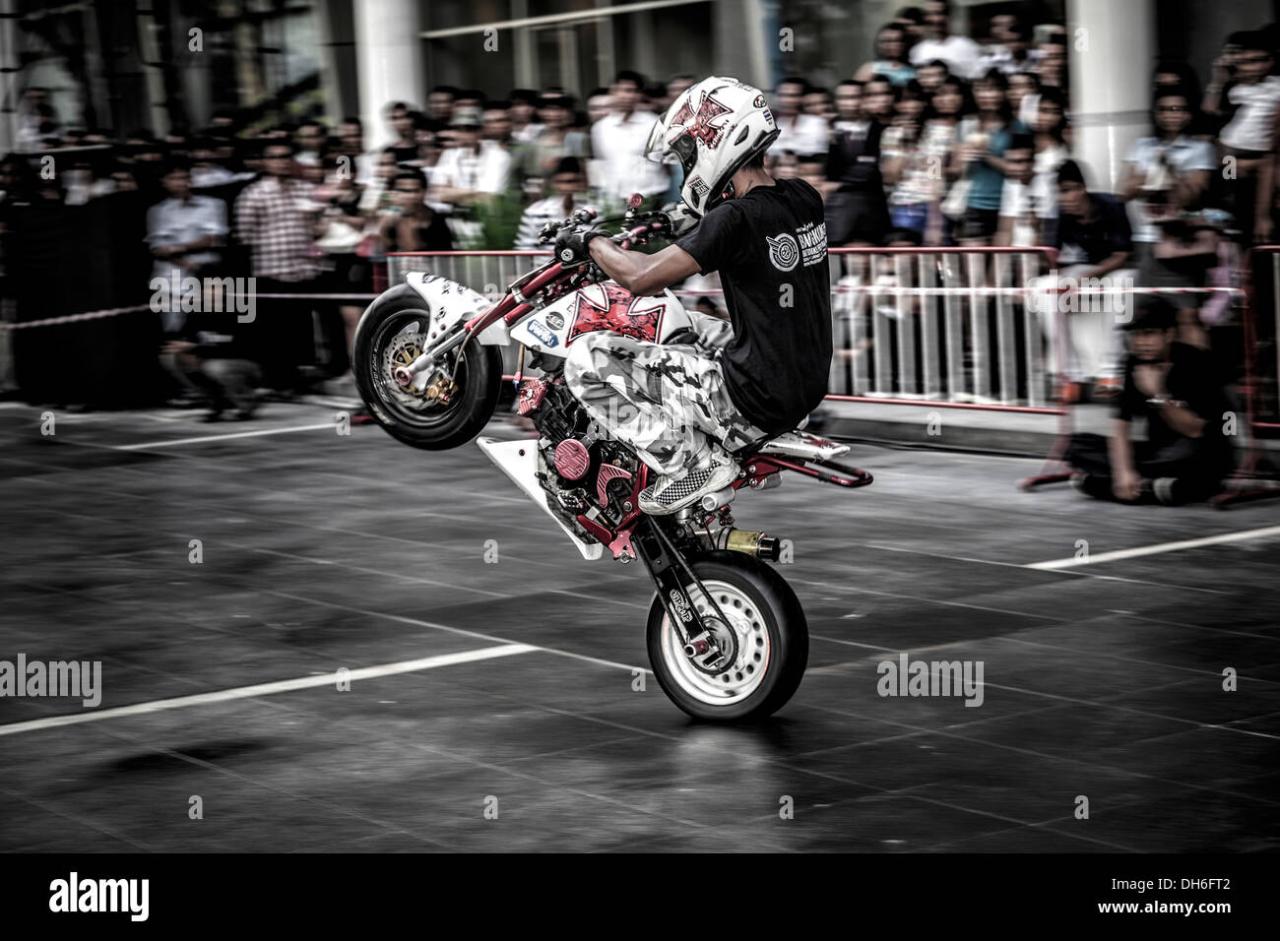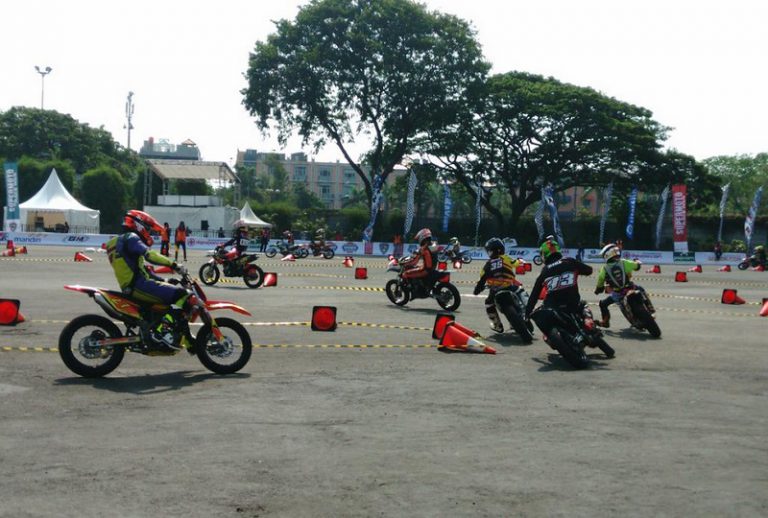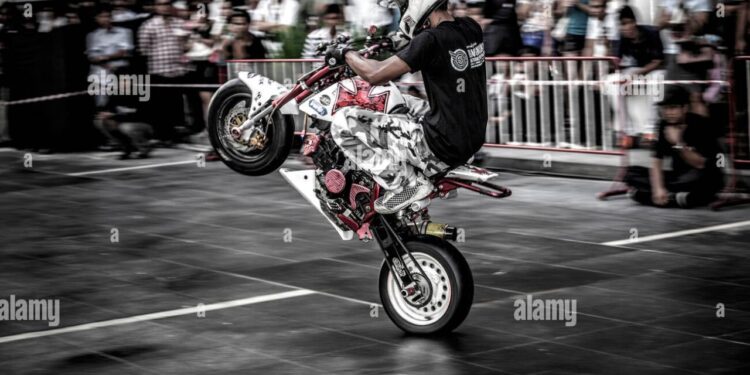Step into the adrenaline-pumping realm of Asia motorcycle stunt competitions, where skill, daring, and innovation collide to create a spectacle like no other. From the rich history of these competitions to the diverse range of stunts performed, this topic promises a deep dive into a captivating world of extreme sports.
Delve into the heart-racing action and cultural influences that shape the landscape of motorcycle stunt competitions across Asia, offering a glimpse into the passion and dedication of riders and teams in this high-octane sport.
Overview of Asia Motorcycle Stunt Competitions

Motorcycle stunt competitions in Asia have a rich history dating back to the early days of motorcycle culture in the region. Stunt riding has always been a popular form of entertainment and competition, captivating audiences with daring feats and impressive displays of skill.
Popularity of Motorcycle Stunt Competitions in Asia
In recent years, the popularity of motorcycle stunt competitions has surged across various Asian countries. Countries like Japan, Thailand, and India have seen a significant rise in the number of participants and spectators at these events. The thrill and excitement of watching skilled riders perform jaw-dropping stunts have drawn in a diverse audience, from adrenaline junkies to casual fans.
Impact of Culture on Stunt Competitions in Asia
The cultural influences in Asia have played a significant role in shaping the development of motorcycle stunt competitions. In countries like India, where motorcycles are deeply ingrained in the cultural fabric, stunt riding has become a way to showcase talent and push the boundaries of traditional motorcycling.
Similarly, countries with a strong history of martial arts, such as Japan, have incorporated elements of discipline and precision into their stunt competitions, creating a unique blend of tradition and modernity in the sport.
Types of Stunts and Competitions

Motorcycle stunt competitions in Asia showcase a variety of impressive skills and tricks that captivate audiences and thrill participants. These competitions often feature a mix of traditional and modern stunts, each requiring precision, control, and daring. Let's explore the different types of stunts commonly seen in Asia and the rules and regulations that govern these competitions.
Common Types of Stunts
- Wheelies: One of the most iconic motorcycle stunts, where the rider lifts the front wheel off the ground while moving forward.
- Stoppies: Also known as nose wheelies, this stunt involves lifting the rear wheel off the ground while balancing on the front wheel.
- Burnouts: A crowd-pleaser where the rider spins the rear wheel while stationary, creating smoke and noise.
- Acrobatics: Complex maneuvers such as backflips, front flips, and other aerial tricks that require skill and agility.
Rules and Regulations
- Protective Gear: Riders must wear helmets, gloves, and other safety gear to ensure their well-being during performances.
- Time Limits: Competitors are often given a specific time frame to showcase their skills, adding an element of challenge and excitement.
- Judging Criteria: Stunts are evaluated based on factors like difficulty, execution, style, and audience engagement.
- Safety Measures: Organizers must adhere to strict safety protocols to prevent accidents and ensure the well-being of participants and spectators.
Comparison of Competition Formats
| Country | Competition Format |
|---|---|
| Japan | Emphasis on precision and technical skills, with a focus on traditional stunts. |
| Thailand | Showcases a mix of traditional and modern stunts, with a high level of creativity and flair. |
| India | Known for its vibrant and energetic performances, combining music and dance elements with stunts. |
Notable Riders and Teams
Asia is home to some of the most talented and renowned motorcycle stunt riders and teams in the world. These individuals and groups have not only showcased their incredible skills but have also played a significant role in shaping the sport of motorcycle stunt riding in Asia.
Famous Motorcycle Stunt Riders
- Hiroyuki Ogawa: Known as the "Godfather of Freestyle Motocross in Japan," Ogawa has been a trailblazer in the sport and has inspired a generation of riders with his innovative stunts.
- Aaron Twite: Hailing from Thailand, Twite is a multiple-time champion in various stunt competitions across Asia and is known for his daring and precise maneuvers on the motorcycle.
- Yuki Takahashi: A prominent figure in the motorcycle stunt scene in Japan, Takahashi is celebrated for his technical prowess and smooth execution of complex stunts.
Prominent Stunt Teams
- Team Zenith: Based in South Korea, Team Zenith is a powerhouse in the world of motorcycle stunt competitions, with their synchronized routines and high-flying stunts captivating audiences worldwide.
- Team Revolution: This Malaysian stunt team has made a name for themselves with their creative choreography and fearless performances, pushing the boundaries of what is possible on a motorcycle.
- Team Samurai: Originating from Japan, Team Samurai is known for their precision and discipline in executing stunts, setting a standard of excellence for aspiring riders in the region.
Safety Measures and Equipment

In any motorcycle stunt competition, safety is of utmost importance to protect the participants and ensure a successful event. Let's delve into the safety measures and equipment required in Asia motorcycle stunt competitions.
Safety Measures Implemented
- Proper Training: Participants must undergo rigorous training to master stunts and techniques before competing to minimize the risk of accidents.
- Safety Briefings: Before each competition, thorough safety briefings are conducted to ensure all participants are aware of the rules and safety protocols.
- Emergency Medical Team: A dedicated medical team is always on standby during competitions to provide immediate assistance in case of injuries.
- Secure Venue: Competitions are held in secure venues with safety barriers and measures in place to protect both participants and spectators.
Essential Safety Equipment
- Helmet: A DOT-approved helmet is mandatory for all participants to protect their head in case of falls or crashes.
- Protective Gear: Riders are required to wear full-body protective gear, including gloves, knee and elbow pads, and armored jackets to reduce the risk of injuries.
- Boots: Sturdy boots with ankle support are essential to provide stability and protection while performing stunts.
- Neck Brace: Some competitions may require riders to wear a neck brace to prevent neck injuries during high-impact stunts.
Role of Safety Standards
Safety standards play a crucial role in promoting responsible stunts in Asia motorcycle competitions by setting guidelines and regulations to ensure the well-being of participants. These standards not only protect the riders but also enhance the overall credibility and reputation of the sport.
By adhering to strict safety measures and equipment requirements, organizers can create a safe environment for riders to showcase their skills without compromising their safety.
Last Word
As we reach the end of this exhilarating discussion on Asia motorcycle stunt competitions, one thing remains clear - the thrill of the ride, the dedication of the competitors, and the unity of a diverse continent brought together by a shared love for extreme sports.
Dive into this world and experience the rush for yourself.
Frequently Asked Questions
What safety measures are in place during Asia motorcycle stunt competitions?
Safety measures include mandatory helmet use, protective gear requirements, and emergency medical personnel on standby during competitions to ensure the well-being of participants.
Are there specific rules governing motorcycle stunts in Asia competitions?
Yes, Asia competitions follow standardized rules regarding the types of stunts allowed, scoring criteria, and penalties for violations to maintain fairness and safety.
Who are some of the most renowned motorcycle stunt riders in Asia?
Some notable riders include [Famous Rider 1], [Famous Rider 2], and [Famous Rider 3], known for their exceptional skills and contributions to the sport.
How do motorcycle stunt competitions vary across different Asian countries?
Stunt competition formats can differ based on cultural influences and local preferences, leading to unique experiences and challenges for riders in various Asian regions.















